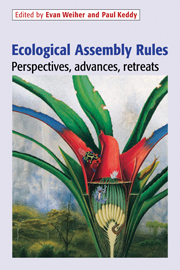Book contents
- Frontmatter
- Contents
- List of Contributors
- Introduction: The scope and goals of research on assembly rules
- Part I The search for meaningful patterns in species assemblages
- 1 The genesis and development of guild assembly rules
- 2 Ruling out a community assembly rule: the method of favored states
- 3 Community structure and assembly rules: confronting conceptual and statistical issues with data on desert rodents
- 4 Introduced avifaunas as natural experiments in community assembly
- 5 Assembly rules in plant communities
- 6 Assembly rules at different scales in plant and bird communities
- 7 Impact of language, history and choice of system on the study of assembly rules
- Part II Other perspectives on community assembly
- Index
2 - Ruling out a community assembly rule: the method of favored states
Published online by Cambridge University Press: 04 September 2009
- Frontmatter
- Contents
- List of Contributors
- Introduction: The scope and goals of research on assembly rules
- Part I The search for meaningful patterns in species assemblages
- 1 The genesis and development of guild assembly rules
- 2 Ruling out a community assembly rule: the method of favored states
- 3 Community structure and assembly rules: confronting conceptual and statistical issues with data on desert rodents
- 4 Introduced avifaunas as natural experiments in community assembly
- 5 Assembly rules in plant communities
- 6 Assembly rules at different scales in plant and bird communities
- 7 Impact of language, history and choice of system on the study of assembly rules
- Part II Other perspectives on community assembly
- Index
Summary
Introduction
Arguments have raged for two decades over the relative importance of interspecific competition and individual species’ responses to the physical environment in determining community composition and about the nature of evidence on this matter (references in Stone, 1996). This debate is one of the most noteworthy features of modern community ecology. Several adherents of the view that competition plays a key role have sought support in patterns detectable in local communities, patterns they feel reflect a governing role for competition in the assembly of communities. The focus here is on one of the most recent such assembly rules, that of Fox and coauthors (1985, 1987, 1989; Fox & Kirkland, 1992; Fox & Brown, 1993), who have modified the assembly rule of Diamond (1975). Applying a null hypothesis approach (cf. Connor & Simberloff, 1979; Gilpin & Diamond, 1982), Fox proposed that a competitive assembly rule, described below, determines how sequential addition constructs communities. His analyses of several data sets seem to confirm this assembly rule and to imply for these communities that competition largely governs their composition.
Fox and Brown (1993) applied a variant of this rule to local communities of North American granivorous desert rodents, finding strong confirmation of Fox's assembly rule (1987). Many people have studied these rodent communities (references in Brown, 1987; Kotler & Brown, 1988), and it is evident that interspecific competition is occurring. Thus, if co-occurrence patterns in any regional communities manifest competition, this should be one such community.
- Type
- Chapter
- Information
- Ecological Assembly RulesPerspectives, Advances, Retreats, pp. 58 - 74Publisher: Cambridge University PressPrint publication year: 1999
- 10
- Cited by

